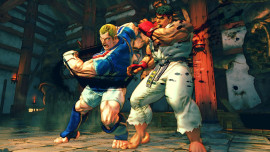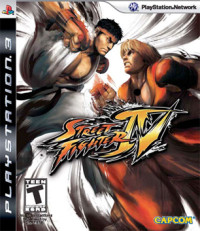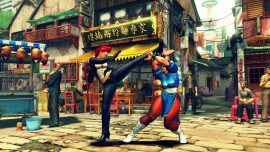
There hasn't been a numbered edition of Street Fighter since Street Fighter III came out in 1999. Now, after 10 years, publisher Capcom has brought Street Fighter back. Does this new game do justice to the arcade classic, or is it doomed to an eternal "YOU LOSE" screen?
A lot of games these days add extra adventure modes and character creation to get the most out of the game. Street Fighter IV goes back to its roots and makes sure that there's only one thing you'll be doing: fighting. If you're a fan of jumping in and playing your games without spending an extra couple hours customizing your facial features or searching for the next objective, you'll be quite relieved. It can be as simple as starting the game, choosing your difficulty, and fighting.
The controls are easy but deep at the same time. First-timers can pick up the controller and do the basics with ease, and veterans will instantly remember how to throw fireballs and hurricane kicks like it was yesterday. All fighters have three punches and three kicks in their arsenals (except the boxer Balrog, who still never learned how to throw a kick), and a wide variety of special moves to take down opponents. Every character also has its own challenge mode in which you can practice and learn special moves and combos, all the way up to an expert level of play. The controls are responsive, and game play doesn't suffer from any major flaws or glitches. If you play in a match against another person and lose, there's no complaining that your controller didn't work for that 45-second period; the person you played against was just better that time.
 There's a solid roster of 25 characters to choose from, 16 at the start with an extra nine to unlock. Fan favorites Ryu, Ken, Guile, and Chun Li return for the fight, while the mixed martial artist Abel and secret agent Crimson Viper are among the new faces. Each character has a unique style, but the characters are balanced; some are faster but not as strong, and vice versa.
There's a solid roster of 25 characters to choose from, 16 at the start with an extra nine to unlock. Fan favorites Ryu, Ken, Guile, and Chun Li return for the fight, while the mixed martial artist Abel and secret agent Crimson Viper are among the new faces. Each character has a unique style, but the characters are balanced; some are faster but not as strong, and vice versa.
Most likely you'll run into some problems dealing with the arcade mode's final opponent, Seth - a giant combination of every character, with the ability to teleport and stretch his limbs like the yoga fighter Dhalsim, giving him an extended reach while keeping him much faster than he should be. This poor design makes him better than every other character, meaning that beating him is more a function of luck than skill. To unlock the other nine characters, you're required to fight this boss repeatedly, which makes getting the full roster tedious. This is the game's primary shortcoming.
The biggest attraction of fighting games lies in multi-player, in which you and a friend can beat the living tar out of each other. Now that the Internet has made playing matches against people all over the world in the comfort of your living room a reality, a game's multi-player functionality is a critical determinant of how long you can play without getting bored. But online play has been problematic at best for fighting games these past couple years. While games such as Super Smash Brothers Brawl, Soul Caliber 4, and Mortal Kombat Vs. DC Universe have all been held in high regard, playing online was riddled with lag, which greatly hurt the experience.
Fortunately, Capcom deliberately delayed Street Fighter IV an extra couple of months for the sake of making sure online play was the best it could be. A gauge during matchmaking shows how good the online connection will be in-game, eliminating most of the guesswork about lag. Out of the 50 online matches played for this review, none had issues with slowdown or lag.
The new 3D graphics help give the series a breath of fresh air. Fans of the original arcade games know that Street Fighter and almost every Capcom fighting game have strong roots in hand-drawn 2D graphics. Fear not, though: Fighting itself is done in a 2D field with 3D character designs, so the only directions you can go, aside from ducking and jumping in the air, are toward your opponent and away. Animated cut scenes are delivered before and after a character's arcade campaign, but they don't fit in well with the higher-quality graphics you see in game play.
 The soundtrack for Street Fighter II back in the early 1990s has mostly been revamped for this modern look at a classic title. Granted, the opening song will sound ridiculous at first because of its pop style, but as annoying as it is, it actually becomes quite catchy. Great care has been put into the sound, making every last punch and kick sound just as brutal as it looks. While the voice acting during the cut scenes has its corny moments, the voices are well done and fit the characters.
The soundtrack for Street Fighter II back in the early 1990s has mostly been revamped for this modern look at a classic title. Granted, the opening song will sound ridiculous at first because of its pop style, but as annoying as it is, it actually becomes quite catchy. Great care has been put into the sound, making every last punch and kick sound just as brutal as it looks. While the voice acting during the cut scenes has its corny moments, the voices are well done and fit the characters.
Ten years without a numbered sequel is a long time in the game industry, but Capcom doesn't put a number behind a game without meaning it. The arcade experience is truly brought home with high-quality online play, the visuals make sure your eyes stay glued to the screen, and the fighting is just as good as it was back in the days of waiting in line for the next match. Despite its minor flaws, if you're looking for the best fighting game available today, my money is on Street Fighter IV.
Luke Hamilton is a buyer, creative designer, and online coordinator for Video Games Etc. He can be reached at ssj_4luke@hotmail.com.










